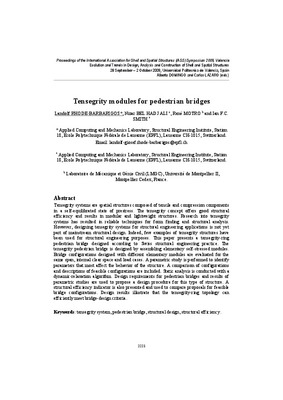JavaScript is disabled for your browser. Some features of this site may not work without it.
Buscar en RiuNet
Listar
Mi cuenta
Estadísticas
Ayuda RiuNet
Admin. UPV
Tensegrity modules for pedestrian bridges
Mostrar el registro sencillo del ítem
Ficheros en el ítem
| dc.contributor.author | RHODE-BARBARIGOS, Landolf
|
|
| dc.contributor.author | BEL HADJ ALI, Nizar
|
|
| dc.contributor.author | MOTRO, RENE
|
|
| dc.contributor.author | SMITH, Ian F. C.
|
|
| dc.contributor.editor | Domingo Cabo, Alberto
|
es_ES |
| dc.contributor.editor | Lázaro Fernández, Carlos Manuel
|
es_ES |
| dc.date.accessioned | 2010-02-24T10:37:22Z | |
| dc.date.available | 2010-02-24T10:37:22Z | |
| dc.date.issued | 2010-02-24T10:37:22Z | |
| dc.identifier.isbn | 978-84-8363-461-5 | |
| dc.identifier.uri | http://hdl.handle.net/10251/7275 | |
| dc.description | p. 2221-2232 | en_EN |
| dc.description.abstract | Tensegrity systems are spatial structures composed of tensile and compression components in a self-equilibrated state of prestress. The tensegrity concept offers good structural efficiency and results in modular and lightweight structures. Research into tensegrity systems has resulted in reliable techniques for form finding and structural analysis. However, designing tensegrity systems for structural engineering applications is not yet part of mainstream structural design. Indeed, few examples of tensegrity structures have been used for structural engineering purposes. This paper presents a tensegrity-ring pedestrian bridge designed according to Swiss structural engineering practice. The tensegrity pedestrian bridge is designed by assembling elementary self-stressed modules. Bridge configurations designed with different elementary modules are evaluated for the same span, internal clear space and load cases. A parametric study is performed to identify parameters that most affect the behavior of the structure. A comparison of configurations and descriptions of feasible configurations are included. Static analysis is conducted with a dynamic-relaxation algorithm. Design requirements for pedestrian bridges and results of parametric studies are used to propose a design procedure for this type of structure. A structural efficiency indicator is also presented and used to compare proposals for feasible bridge configurations. Design results illustrate that the tensegrity-ring topology can efficiently meet bridge-design criteria. | en_EN |
| dc.language | Inglés | en_EN |
| dc.publisher | Editorial Universitat Politècnica de València | es_ES |
| dc.relation.ispartof | Symposium of the International Association for Shell and Spatial Structures (50th. 2009. Valencia). Evolution and Trends in Design, Analysis and Construction of Shell and Spatial Structures : Proceedings | en_EN |
| dc.rights | Reserva de todos los derechos | en_EN |
| dc.subject | Tensegrity system | en_EN |
| dc.subject | Pedestrian bridge | en_EN |
| dc.subject | Structural design | en_EN |
| dc.subject | Structural efficiency | en_EN |
| dc.title | Tensegrity modules for pedestrian bridges | en_EN |
| dc.type | Comunicación en congreso | en_EN |
| dc.rights.accessRights | Abierto | es_ES |
| dc.description.bibliographicCitation | Rhode-Barbarigos, L.; Bel Hadj Ali, N.; Motro, R.; Smith, IFC. (2010). Tensegrity modules for pedestrian bridges. Editorial Universitat Politècnica de València. http://hdl.handle.net/10251/7275 | es_ES |
| dc.relation.conferencename | Symposium of the International Association for Shell and Spatial Structures | es_ES |
| dc.relation.conferencedate | 2009 | es_ES |
| dc.relation.conferenceplace | Valencia | es_ES |






